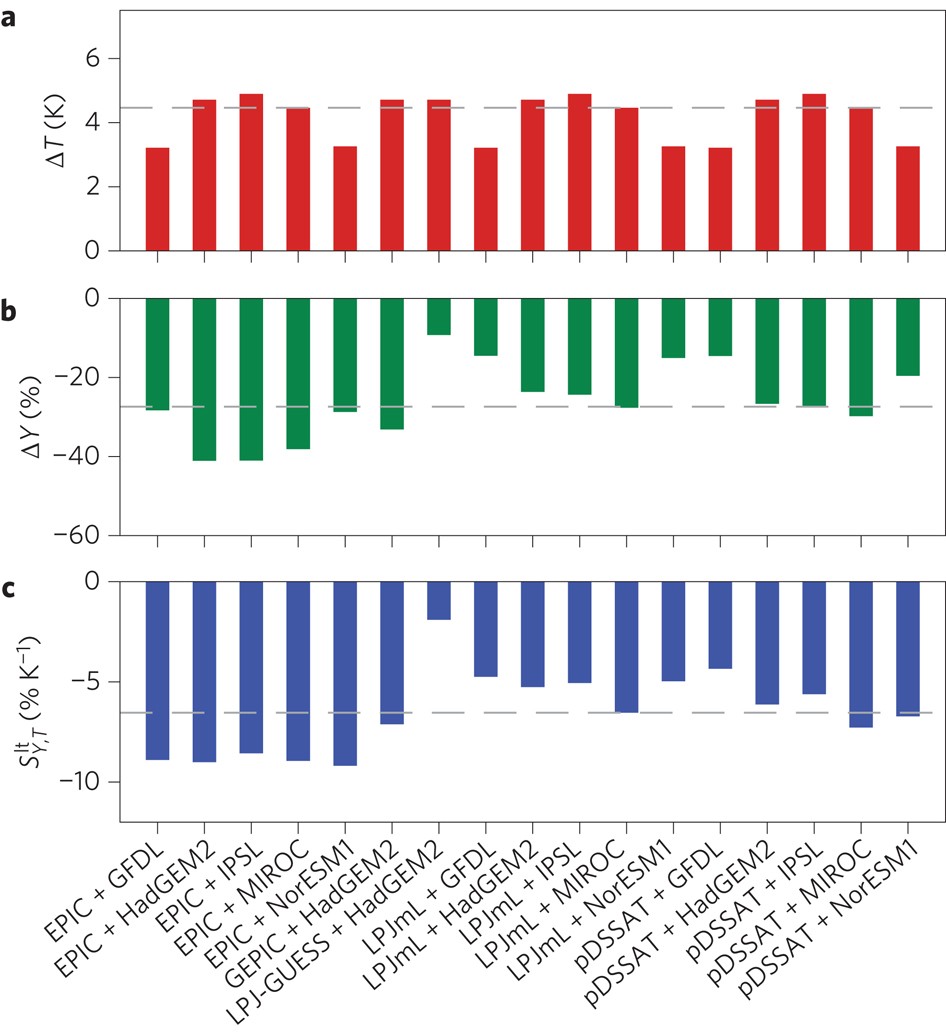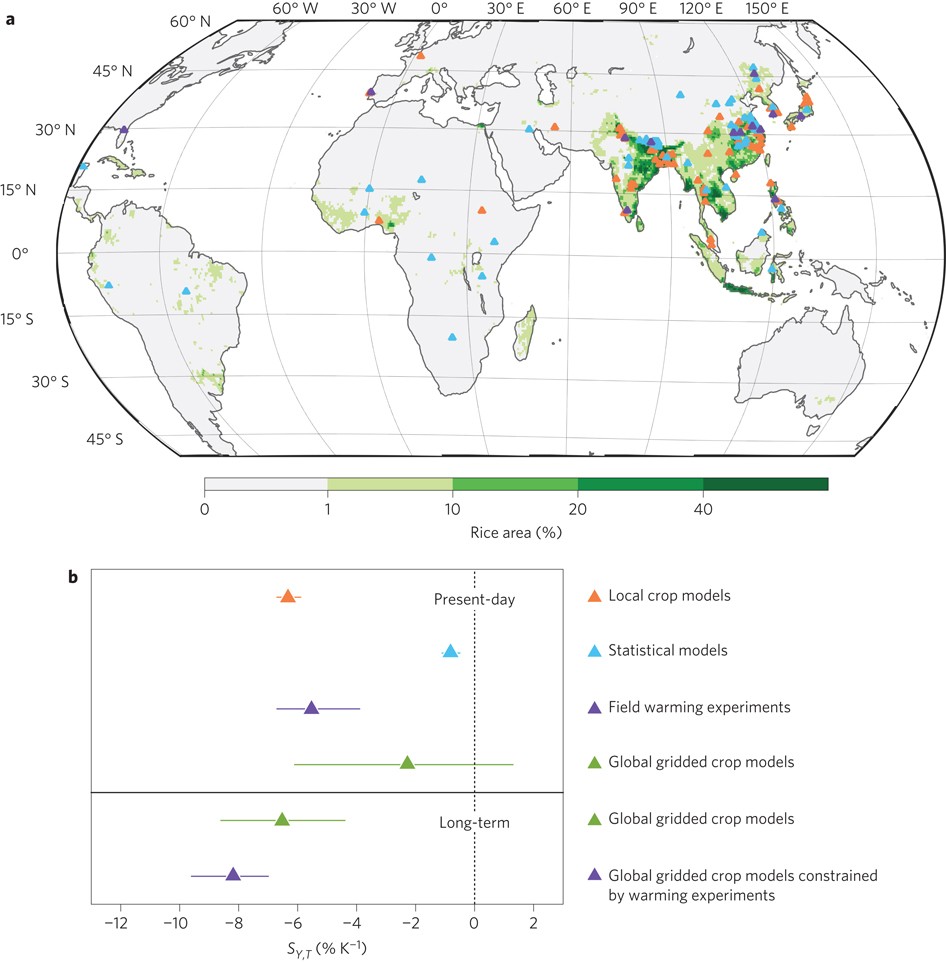文章信息:Zhao Chuang, Piao Shilong, Wang Xuhui, Huang Yao, Philippe Ciais, Joshua Elliott, Mengtian Huang, Ivan A. Janssens, Li Tao, Lian Xu, Liu Yongwen, Christoph Müller, Peng Shushi, Wang Tao, Zeng Zhenzhong, & Josep Peñuelas. (2016). Plausible rice yield losses under future climate warming. Nature Plants: 3(1), 1–5. https://doi.org/10.1038/nplants.2016.202
整理人:杨文,2023级硕士生
整理时间:2024年7月7日
Abstract: Rice is the staple food for more than 50% of the world's population1–3. Reliable prediction of changes in rice yield is thus central for maintaining global food security. This is an extraordinary challenge. Here, we compare the sensitivity of rice yield to temperature increase derived from field warming experiments and three modelling approaches: statistical models, local crop models and global gridded crop models. Field warming experiments produce a substantial rice yield loss under warming, with an average temperature sensitivity of −5.2 ± 1.4% K−1. Local crop models give a similar sensitivity (−6.3 ± 0.4% K−1), but statistical and global gridded crop models both suggest less negative impacts of warming on yields (−0.8 ± 0.3% and −2.4 ± 3.7% K−1, respectively). Using data from field warming experiments, we further propose a conditional probability approach to constrain the large range of global gridded crop model results for the future yield changes in response to warming by the end of the century (from −1.3% to −9.3% K−1). The constraint implies a more negative response to warming (−8.3 ± 1.4% K−1) and reduces the spread of the model ensemble by 33%. This yield reduction exceeds that estimated by the International Food Policy Research Institute assessment (−4.2 to −6.4% K−1) (ref. 4). Our study suggests that without CO2 fertilization, effective adaptation and genetic improvement, severe rice yield losses are plausible under intensive climate warming scenarios.
摘要:稻米是全球50%以上人口的主食。可靠地预测稻米产量变化对于维护全球粮食安全至关重要。这是一个非同寻常的挑战。在这里,我们比较了田间加热实验和三种建模方法(统计模型、当地作物模型和全球格网作物模型)得出的稻米产量对温度升高的敏感性。田间加热实验表明,在加热下稻米产量大幅减少,平均温度敏感性为-5.2±1.4% K−1。当地作物模型给出类似的敏感性(-6.3±0.4% K−1),但统计模型和全球格网作物模型都表示对产量的加热影响较小(分别为-0.8±0.3%和-2.4±3.7% K−1)。利用来自田间加热实验的数据,我们进一步提出了一种条件概率方法,以限制全球格网作物模型在本世纪末对未来产量变化的大范围结果(从-1.3%到-9.3% K−1)。这一限制意味着对加热的更负面响应(-8.3±1.4% K−1),减少了模型集合的差异性达33%。这种产量减少超过了国际粮食政策研究所评估的估计(-4.2%至-6.4% K−1)(参见文献4)。我们的研究表明,在没有二氧化碳施肥、有效的适应和遗传改良的情况下,密集气候变暖情景下出现严重的稻米产量损失是可能的。

图 未来气候变化(2070–2099,RCP8.5)及其对全球水稻产量的影响(与1971–2000年的基线相比),来自17对GGCM–CM组合,没有二氧化碳施肥效应
a、 生长季节温度变化(ΔT)。b、 相对产量变化(ΔY)。c、 水稻产量对气候变化的长期敏感性。虚线表示集合的中值。GFDL、HadGEM2、IPSL、MIROC和NorESM1分别表示CM GFDL-ESM2M、HadGEM2 ES、IPSL-CM5A-LR、MIROC-ESM-CHEM和NorESM1-M。

图 从四种不同的方法估算水稻产量对温度变化的敏感性
a、 根据当地作物模型、统计模型和田间变暖实验绘制的研究地点地图。区域尺度的研究由区域中心的相应标签表示(未显示一项全球尺度的研究)。使用Matlab R2014b创建地图。b、 水稻产量对温度变化的所有当前和长期敏感性的估计(SY,T)。来自GGCM的SY、T是所有全局网格单元的平均值,但不是场变暖实验所在的网格单元。误差条显示标准偏差。
原文链接:https://www.nature.com/articles/nplants2016202